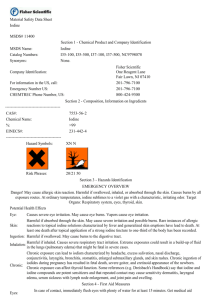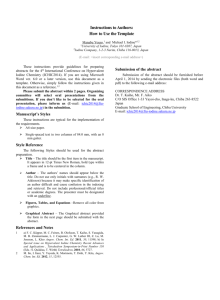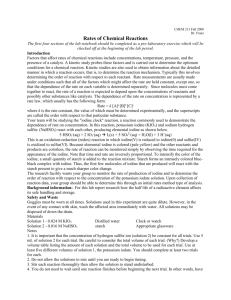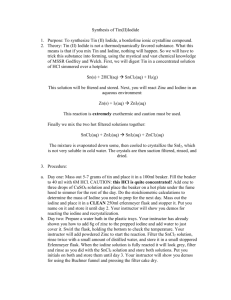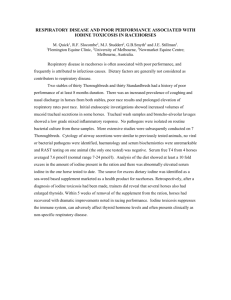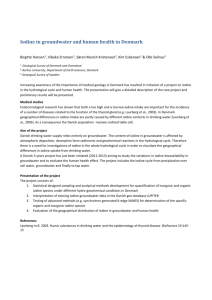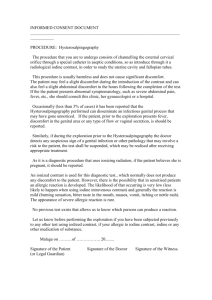IODINE TINCTURE 2%
advertisement
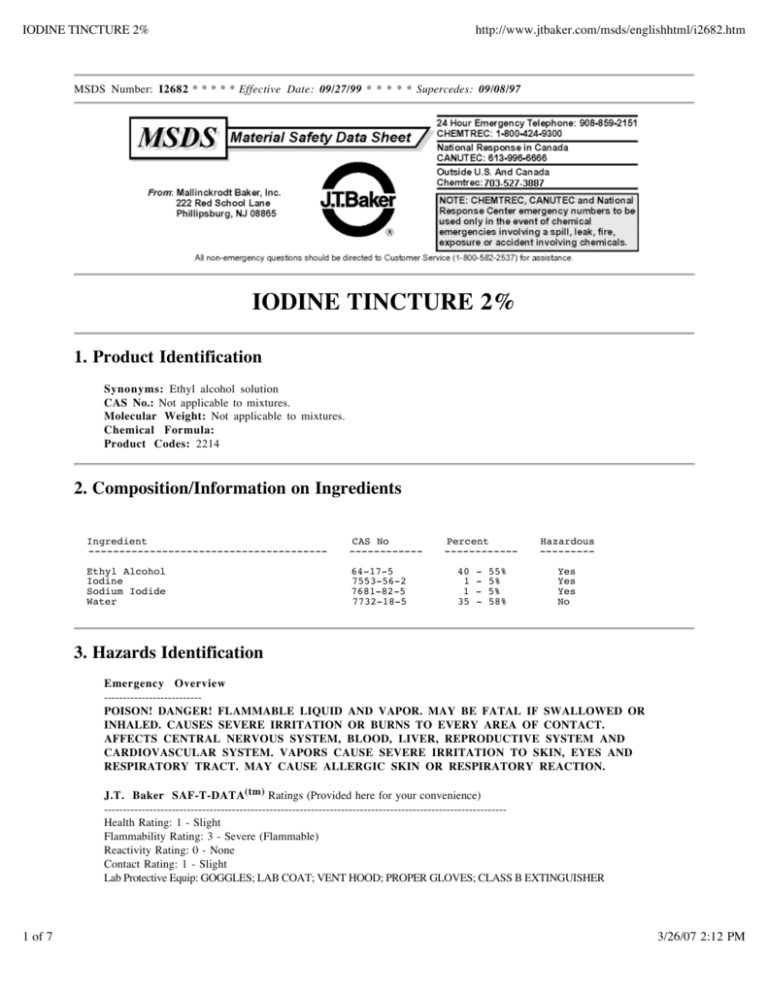
IODINE TINCTURE 2% http://www.jtbaker.com/msds/englishhtml/i2682.htm MSDS Number: I2682 * * * * * Effective Date: 09/27/99 * * * * * Supercedes: 09/08/97 IODINE TINCTURE 2% 1. Product Identification Synonyms: Ethyl alcohol solution CAS No.: Not applicable to mixtures. Molecular Weight: Not applicable to mixtures. Chemical Formula: Product Codes: 2214 2. Composition/Information on Ingredients Ingredient --------------------------------------- CAS No ------------ Ethyl Alcohol Iodine Sodium Iodide Water 64-17-5 7553-56-2 7681-82-5 7732-18-5 Percent -----------40 1 1 35 - 55% 5% 5% 58% Hazardous --------Yes Yes Yes No 3. Hazards Identification Emergency Overview -------------------------POISON! DANGER! FLAMMABLE LIQUID AND VAPOR. MAY BE FATAL IF SWALLOWED OR INHALED. CAUSES SEVERE IRRITATION OR BURNS TO EVERY AREA OF CONTACT. AFFECTS CENTRAL NERVOUS SYSTEM, BLOOD, LIVER, REPRODUCTIVE SYSTEM AND CARDIOVASCULAR SYSTEM. VAPORS CAUSE SEVERE IRRITATION TO SKIN, EYES AND RESPIRATORY TRACT. MAY CAUSE ALLERGIC SKIN OR RESPIRATORY REACTION. J.T. Baker SAF-T-DATA(tm) Ratings (Provided here for your convenience) ----------------------------------------------------------------------------------------------------------Health Rating: 1 - Slight Flammability Rating: 3 - Severe (Flammable) Reactivity Rating: 0 - None Contact Rating: 1 - Slight Lab Protective Equip: GOGGLES; LAB COAT; VENT HOOD; PROPER GLOVES; CLASS B EXTINGUISHER 1 of 7 3/26/07 2:12 PM IODINE TINCTURE 2% http://www.jtbaker.com/msds/englishhtml/i2682.htm Storage Color Code: Red (Flammable) ----------------------------------------------------------------------------------------------------------Potential Health Effects ---------------------------------Iodine Component: The following hazards are for concentrated solutions. Hazards of less concentrated solutions should be reduced. Inhalation: Ethyl Alcohol Component: Vapors may irritate mucous membranes of upper respiratory tract. Prolonged exposure to high air concentration of ethyl alcohol may produce drowsiness, loss of appetite, and intoxication. Iodine Component: Vapors severely irritate and can burn the mucous membranes and respiratory tract. Excessive tears, rhinitis, tightness in the chest, sore throat, headache and delayed pulmonary edema can result. Inhalation of concentrated vapors may be fatal. Ingestion: Ethyl Alcohol Component: Large oral doses may produce burning sensation in mouth and esophagus as well as gastrointestinal disturbances, sleep disorders, and central nervous system effects. Iodine Component: Can cause severe burns of the mouth, throat and stomach. Causes abdominal pain, diarrhea, fever, vomiting, stupor and shock. Probable lethal dose is 2 to 4 gm of free iodine. Skin Contact: Ethyl Alcohol Component: May cause skin discoloration with irritation. Irritating due to defatting action on skin. Causes redness, pain, drying and cracking of the skin. Iodine Component: Contact may cause blistering burns, irritation, and pain. Vapors may be severely irritating to the skin. Eye Contact: Ethyl Alcohol Component: Vapors can cause irritation. Splashes can cause severe irritation and possibly eye damage. Iodine Component: Vapors are severely irritating and may cause damage to the eyes. Contact may cause severe burns and permanent eye damage. Chronic Exposure: Ethyl Alcohol Component: Prolonged contact may cause skin discoloration. May cause drying cracking, and dermatitis. Ethanol may cause reproductive effects such as birth defects, developmental problems and may damage the reproductive system. Repeated high exposure may damage the liver, nervous system and blood cells. Iodine Component: Chronic exposure to iodine may cause insomnia, conjunctivitis, inflammation of the nasal mucous, bronchitis, tremor, rapid heart beat, diarrhea and weight loss. Allergic sensitization may occur. Chronic iodine overdoses have produced iodism. Headache, fever, sneezing, salivation, and skin rashes may occur. Aggravation of Pre-existing Conditions: Persons with pre-existing skin disorders, eye problems, impaired respiratory function, or disease of the thyroid, lungs, or kidney may be more susceptible to the effects of the substance. 4. First Aid Measures Inhalation: Remove to fresh air. If not breathing, give artificial respiration. If breathing is difficult, give oxygen. Get medical attention immediately. Observe for the development of pulmonary edema. Ingestion: Induce vomiting immediately as directed by medical personnel. Never give anything by mouth to an unconscious person. Get medical attention immediately. Skin Contact: Wipe off excess material from skin then immediately flush skin with plenty of water for at least 15 minutes while 2 of 7 3/26/07 2:12 PM IODINE TINCTURE 2% http://www.jtbaker.com/msds/englishhtml/i2682.htm removing contaminated clothing and shoes. Get medical attention immediately. Wash clothing before reuse. Thoroughly clean shoes before reuse. Iodine stains can be removed by immediately washing skin with 5% sodium thiosulfate solution. Eye Contact: Immediately flush eyes with plenty of water for at least 15 minutes, lifting lower and upper eyelids occasionally. Get medical attention immediately. 5. Fire Fighting Measures Fire: Flash point: 22C (72F) CC Autoignition temperature: 363C (685F) Flammable limits in air % by volume: lel: 3.3; uel: 19 Flammable Liquid and Vapor! Flash point is applicable for 60% ethanol. All other fire data is for pure ethanol. Explosion: Above flash point, vapor-air mixtures are explosive within flammable limits noted above. Sensitive to static discharge. Fire Extinguishing Media: Dry chemical, alcohol foam or carbon dioxide. Water may be ineffective. Use water spray to cool fire-exposed containers, to dilute liquid, and control vapor. Special Information: In the event of a fire, wear full protective clothing and NIOSH-approved self-contained breathing apparatus with full facepiece operated in the pressure demand or other positive pressure mode. Water may be used to flush spills away from exposures and to dilute spills to non-flammable mixtures. 6. Accidental Release Measures Ventilate area of leak or spill. Remove all sources of ignition. Wear appropriate personal protective equipment as specified in Section 8. Isolate hazard area. Keep unnecessary and unprotected personnel from entering. Contain and recover liquid when possible. Use non-sparking tools and equipment. Collect liquid in an appropriate container or absorb with an inert material (e. g., vermiculite, dry sand, earth), and place in a chemical waste container. Do not use combustible materials, such as saw dust. Do not flush to sewer! J. T. Baker SOLUSORB® solvent adsorbent is recommended for spills of this product. 7. Handling and Storage Protect against physical damage. Store in a cool, dry well-ventilated location, away from any area where the fire hazard may be acute. Outside or detached storage is preferred. Separate from incompatibles. Containers should be bonded and grounded for transfers to avoid static sparks. Storage and use areas should be No Smoking areas. Use non-sparking type tools and equipment, including explosion proof ventilation. Containers of this material may be hazardous when empty since they retain product residues (vapors, liquid); observe all warnings and precautions listed for the product. 8. Exposure Controls/Personal Protection Airborne Exposure Limits: Iodine Component: -OSHA Permissible Exposure Limit (PEL): 0.1 ppm Ceiling -ACGIH Threshold Limit Value (TLV): 0.1 ppm (STEL) ceiling 3 of 7 3/26/07 2:12 PM IODINE TINCTURE 2% http://www.jtbaker.com/msds/englishhtml/i2682.htm For Ethyl Alcohol: - OSHA Permissible Exposure Limit (PEL): 1,000 ppm (TWA) - ACGIH Threshold Limit Value (TLV): 1,000 ppm (TWA), A4 (Not Classifiable as a Human Carcinogen) Ventilation System: A system of local and/or general exhaust is recommended to keep employee exposures below the Airborne Exposure Limits. Local exhaust ventilation is generally preferred because it can control the emissions of the contaminant at its source, preventing dispersion of it into the general work area. Please refer to the ACGIH document, Industrial Ventilation, A Manual of Recommended Practices, most recent edition, for details. Use explosion-proof equipment. Personal Respirators (NIOSH Approved): If the exposure limit is exceeded, wear a supplied air, full-facepiece respirator, airlined hood, or full-facepiece self-contained breathing apparatus. This substance has poor warning properties. Skin Protection: Wear impervious protective clothing, including boots, gloves, lab coat, apron or coveralls, as appropriate, to prevent skin contact. Eye Protection: Use chemical safety goggles and/or a full face shield where splashing is possible. Maintain eye wash fountain and quick-drench facilities in work area. 9. Physical and Chemical Properties Appearance: Clear, reddish brown liquid. Odor: Characteristic iodine odor. Solubility: Miscible in water. Specific Gravity: 0.95 - 1.0 pH: No information found. % Volatiles by volume @ 21C (70F): > 90 (as water and alcohol) Boiling Point: No information found. Melting Point: No information found. Vapor Density (Air=1): No information found. Vapor Pressure (mm Hg): No information found. Evaporation Rate (BuAc=1): No information found. 10. Stability and Reactivity Stability: Stable under ordinary conditions of use and storage. Hazardous Decomposition Products: Carbon dioxide and carbon monoxide may form when heated to decomposition. Burning may produce toxic iodine vapors. Hazardous Polymerization: Will not occur. Incompatibilities: Ethyl Alcohol Component: 4 of 7 3/26/07 2:12 PM IODINE TINCTURE 2% http://www.jtbaker.com/msds/englishhtml/i2682.htm Strong oxidizing agents and many other substances. Iodine Component: Ammonia, strong acids, powdered metals, alkali metals, acetaldehyde, acetylene, ammonium hydroxide, and strong reducing agents. Conditions to Avoid: Heat, flames, ignition sources and incompatibles. 11. Toxicological Information Toxicological Data: Sodium iodide: Oral rat LD50: 4340 mg/kg Irritation skin rabbit, Standard Draize: 500 mg/24H, moderate; Eye rabbit, Standard Draize: 100 mg/24H, investigated as a reproductive effector. Ethyl Alcohol: Oral rat LD50: 7060 mg/kg; Inhalation rat LC50: 20,000 ppm/10-hour; Irritation skin rabbit, Standard Draize: 20 mg/24H, moderate; eye rabbit, Standard Draize: 500 mg/24H severe; Investigated as a tumorigen, mutagen, and a reproductive effector. Iodine Component: Oral rat LD50: 14 gm/kg; Human LDLo: 28 mg/kg; Investigated as a reproductive effector. Reproductive Toxicity: Ethanol has been linked to birth defects in humans. Occasional uses of iodides for asthma in pregnancy has resulted in fetal death, severe goiter, and cretinoid appearance of the newborn. Carcinogenicity: Ethanol has been linked to cancer in humans. Chronic ethanol ingestion is associated with liver cancer. Most industrial ethanol contains denaturants that render it undesirable to drink. --------\Cancer Lists\--------------------------------------------------------NTP Carcinogen--Ingredient Known Anticipated IARC Category -------------------------------------------------------------Ethyl Alcohol (64-17-5) No No None Iodine (7553-56-2) No No None Sodium Iodide (7681-82-5) No No None Water (7732-18-5) No No None 12. Ecological Information Environmental Fate: The following statements refer to the environmental fate of ethanol. When released into the soil, this material is expected to readily biodegrade. When released into the soil, this material may leach into groundwater. When released into the soil, this material is expected to quickly evaporate. When released into water, this material is expected to readily biodegrade. When released into water, this material may evaporate to a moderate extent. This material is not expected to significantly bioaccumulate. When released into the air, this material is expected to be readily degraded by reaction with photochemically produced hydroxyl radicals. When released into the air, this material is expected to be readily removed from the atmosphere by wet deposition. The following statements refer to the environmental fate of iodine. This material has a log octanol-water partition coefficient of less than 3.0. This material is not expected to significantly bioaccumulate. Environmental Toxicity: The following information refers to the toxicity of ethanol. This material is not expected to be toxic to aquatic life. The LC50/96-hour values for fish are over 100 mg/l. 13. Disposal Considerations Whatever cannot be saved for recovery or recycling should be handled as hazardous waste and sent to a RCRA approved incinerator or disposed in a RCRA approved waste facility. Processing, use or contamination of this product may change the waste management options. State and local disposal regulations may differ from federal disposal 5 of 7 3/26/07 2:12 PM IODINE TINCTURE 2% http://www.jtbaker.com/msds/englishhtml/i2682.htm regulations. Dispose of container and unused contents in accordance with federal, state and local requirements. 14. Transport Information Domestic (Land, D.O.T.) ----------------------Proper Shipping Name: ETHANOL SOLUTION Hazard Class: 3 UN/NA: UN1170 Packing Group: II Information reported for product/size: 500ML International (Water, I.M.O.) ----------------------------Proper Shipping Name: ETHANOL SOLUTION Hazard Class: 3.2 UN/NA: UN1170 Packing Group: II Information reported for product/size: 500ML International (Air, I.C.A.O.) ----------------------------Proper Shipping Name: ETHANOL SOLUTION Hazard Class: 3 UN/NA: UN1170 Packing Group: II Information reported for product/size: 500ML 15. Regulatory Information --------\Chemical Inventory Status - Part 1\--------------------------------Ingredient TSCA EC Japan Australia ----------------------------------------------- ---- --- ----- --------Ethyl Alcohol (64-17-5) Yes Yes Yes Yes Iodine (7553-56-2) Yes Yes No Yes Sodium Iodide (7681-82-5) Yes Yes Yes Yes Water (7732-18-5) Yes Yes Yes Yes --------\Chemical Inventory Status - Part 2\----------------------------------Canada-Ingredient Korea DSL NDSL Phil. ----------------------------------------------- ----- ------ ----Ethyl Alcohol (64-17-5) Yes Yes No Yes Iodine (7553-56-2) Yes Yes No Yes Sodium Iodide (7681-82-5) Yes Yes No Yes Water (7732-18-5) Yes Yes No Yes --------\Federal, State & International Regulations - Part 1\----------------SARA 302------SARA 313-----Ingredient RQ TPQ List Chemical Catg. ----------------------------------------- ---------- -------------Ethyl Alcohol (64-17-5) No No No No Iodine (7553-56-2) No No No No Sodium Iodide (7681-82-5) No No No No Water (7732-18-5) No No No No --------\Federal, State & International Regulations - Part 2\----------------RCRA-TSCAIngredient CERCLA 261.33 8(d) ----------------------------------------- ---------------Ethyl Alcohol (64-17-5) No No No Iodine (7553-56-2) No No No Sodium Iodide (7681-82-5) No No No Water (7732-18-5) No No No Chemical Weapons Convention: 6 of 7 No TSCA 12(b): No CDTA: No 3/26/07 2:12 PM IODINE TINCTURE 2% SARA 311/312: Acute: Yes Chronic: Yes Reactivity: No (Mixture / Liquid) http://www.jtbaker.com/msds/englishhtml/i2682.htm Fire: Yes Pressure: No Australian Hazchem Code: 2[S]E Poison Schedule: S6 WHMIS: This MSDS has been prepared according to the hazard criteria of the Controlled Products Regulations (CPR) and the MSDS contains all of the information required by the CPR. 16. Other Information NFPA Ratings: Health: 2 Flammability: 3 Reactivity: 0 Label Hazard Warning: POISON! DANGER! FLAMMABLE LIQUID AND VAPOR. MAY BE FATAL IF SWALLOWED OR INHALED. CAUSES SEVERE IRRITATION OR BURNS TO EVERY AREA OF CONTACT. AFFECTS CENTRAL NERVOUS SYSTEM, BLOOD, LIVER, REPRODUCTIVE SYSTEM AND CARDIOVASCULAR SYSTEM. VAPORS CAUSE SEVERE IRRITATION TO SKIN, EYES AND RESPIRATORY TRACT. MAY CAUSE ALLERGIC SKIN OR RESPIRATORY REACTION. Label Precautions: Keep away from heat, sparks and flame. Use only with adequate ventilation. Do not breathe vapor or mist. Keep container closed. Do not get in eyes, on skin, or on clothing. Wash thoroughly after handling. Label First Aid: If swallowed, induce vomiting immediately as directed by medical personnel. Never give anything by mouth to an unconscious person. If inhaled, remove to fresh air. If not breathing, give artificial respiration. If breathing is difficult, give oxygen. In case of contact, wipe off excess material from skin then immediately flush eyes or skin with plenty of water for at least 15 minutes while removing contaminated clothing and shoes. Wash clothing before reuse. In all cases get medical attention immediately. Product Use: Laboratory Reagent. Revision Information: MSDS Section(s) changed since last revision of document include: 5. Disclaimer: ************************************************************************************************ Mallinckrodt Baker, Inc. provides the information contained herein in good faith but makes no representation as to its comprehensiveness or accuracy. This document is intended only as a guide to the appropriate precautionary handling of the material by a properly trained person using this product. Individuals receiving the information must exercise their independent judgment in determining its appropriateness for a particular purpose. MALLINCKRODT BAKER, INC. MAKES NO REPRESENTATIONS OR WARRANTIES, EITHER EXPRESS OR IMPLIED, INCLUDING WITHOUT LIMITATION ANY WARRANTIES OF MERCHANTABILITY, FITNESS FOR A PARTICULAR PURPOSE WITH RESPECT TO THE INFORMATION SET FORTH HEREIN OR THE PRODUCT TO WHICH THE INFORMATION REFERS. ACCORDINGLY, MALLINCKRODT BAKER, INC. WILL NOT BE RESPONSIBLE FOR DAMAGES RESULTING FROM USE OF OR RELIANCE UPON THIS INFORMATION. ************************************************************************************************ Prepared by: Environmental Health & Safety Phone Number: (314) 654-1600 (U.S.A.) 7 of 7 3/26/07 2:12 PM

